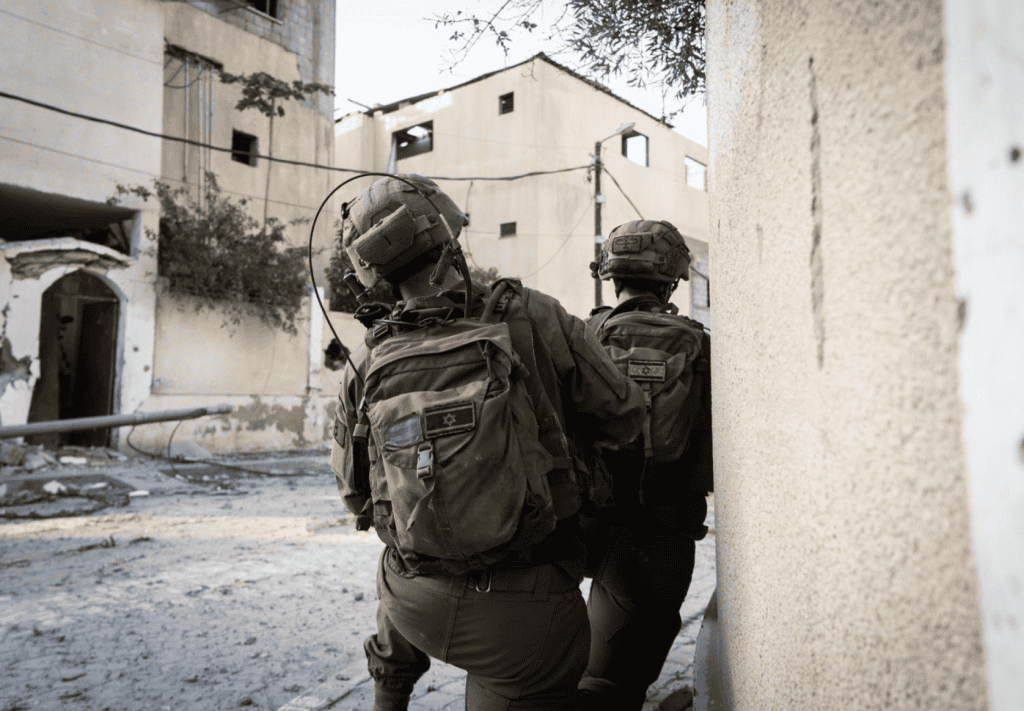
The Israel Defense Forces have sent the Bislamach infantry brigade into the “heart of Khan Younis” to operate against Hamas terrorists in the southern Gaza city. This marks a new phase in operations in the city, which began in early December. The 98th division of commandos and paratroops, bolstered by the 7th armored brigade, have been fighting Hamas in Khan Younis for three months.
Now, according to reports, the paratrooper brigade is being redeployed. The Bislamach brigade, which is based around a training unit, had been operating in the neighborhoods of Daraj and Tuffah near Gaza City’s center in December. It was then redeployed at the end of December. The deployment of the brigade appears to represent a less intense phase of fighting in Khan Younis.
Khan Younis is the hometown of Hamas leader Yahya Sinwar, and it was also home to one of the largest and most powerful Hamas brigades. There were several Hamas battalions in the city with several thousand fighters. Hamas terrorists had set off from areas near the city, from Khirbat Ikhza’a and Khuza’a near the border with Israel, on October 7. Hostages were transported back to Khan Younis after the attack. In addition, a video of Sinwar in a tunnel under Khan Younis in the early days of the war was found by the IDF.
When the IDF first entered the city, it did so rapidly and by using commandos and paratroops of the 98th division. It also deployed tanks from the 7th armored and Givati infantry and other forces. The 98th also used new technology in the city, including the IDF’s new precision Iron Sting mortars. The 120mm mortar is deployed via a Humvee in which the launch tube is deployed from the rear of the vehicle. The mortar uses data imported from the computer and can then be used to conduct precision fire. This gives infantry in the field the opportunity to conduct precise strikes rather than waiting for air support.
Despite successes in Khan Younis, the battle has been grinding on. The IDF found extensive tunnels and evidence of hostages, but did not free any hostages in the city. Although it eliminated Hamas battalions, it did not find top Hamas commanders. Khan Younis is close to the city of Rafah, which sits on the Egyptian border. There are believed to be several Hamas battalions operating out of Rafah as their last major bastion in Gaza, surrounded by more than 1 million displaced Gazans. Once the IDF gained total control over Khan Younis, this likely contributed to the freedom of action that enabled them to conduct a raid in Rafah that freed two hostages in mid-February. That raid used the IDF’s new Eitan APCs which are wheeled and can drive on roads at a high speed to extract the two hostages and special forces and move them to a helicopter.
Now, the IDF says it has operated in Khan Younis to eliminate terrorists who carried out rocket launches at Israel and eliminate several terrorists who were carrying weapons. “Over the past day, IDF troops conducted targeted raids on a series of targets in western Khan Yunis. During the activity, the troops located a weapon storage facility containing numerous AK-47 rifles and ammunition. Additionally, four terrorists approached IDF troops, which directed an aircraft, that targeted and killed the terrorists,” the IDF said. In addition, the IDF said the 7th armored brigade raided several homes of Hamas commanders.
Abasan, a suburb of Khan Younis, was also targeted by Israeli infantry during the last week of February. “Dozens” of targets were hit by the IDF Givati infantry brigade’s fire control center, the IDF said. Two soldiers were killed in clashes in the area. The IDF says Abasan is important to control because terrorists used it as a staging area for attacks on three Israeli border communities on October 7.
The continued fighting throughout Gaza, from Zaytun in the north near Gaza City to central Gaza and Khan Younis illustrates the continued challenge posed by Hamas. The IDF is also focusing on securing a zone called the Netzarim corridor which cuts across the center of Gaza, dividing the strip into two parts. This is supposed to make isolating remaining terrorists in the north and south easier and enable rapid maneuver into those areas to conduct new sweeps.







